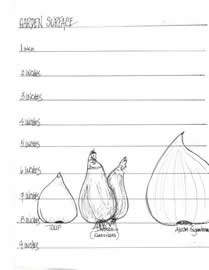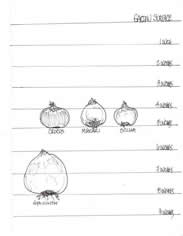In-Depth Information About Winter Hardy Bulbs
| These Yellow Daffodils are "true bulbs" |
The term “bulb” is used to describe a variety of bulbous plants including true bulbs, corms, tubers and rhizomes.
True bulbs grow in layers, much like an onion. At one end is the basal plate (a flat surface with immature roots). There are two groups of true bulbs, scaly and tunicate. Tunicate bulbs have a papery surface and scaly bulbs a more leathery one. There are also hardy and tender bulbs. Hardy bulbs are planted in the fall and bloom in the spring. Tender bulbs are planted in the spring and bloom in the summer. Scaly bulbs include Asiatic lilies.
| Daffodils are a typical example of a tunicate bulb |
Tunicate bulbs include tulips, daffodils, narcissus etc. Bulbs reproduce by offsets; tiny bulbs attached to the main, large bulb.
Corms are somewhat similar in appearance to true bulbs but do not grow in layers. Corms are, actually, a compressed stem that contains food and has a bud on the top. Crocus, gladiolus and tuberous begonias are included in this group. As the flower grows, the corm shrivels as its nutrients are depleted. It does, however, produce new corms next to or above the original corm.
Tubers have leathery skin and “eyes” or buds, like a potato. Each of these “eyes” is a location where new plants will emerge. Dahlias, caladiums and anemones are in this group.
Rhizomes are underground stems that grow just below the surface. They grow horizontally, producing many new plants. Iris hybrids and Calla lilies fall into this category.
All of the above types of bulbous plants act as storage structures for food. As noted in the BULB 101 article, all these bulbs prefer a well-drained soil. They can become moldy and rot if planted in heavy clay. Planting depth can matter. Planting deeper than normal will delay bloom time.
 |
| Large bulb planting depths |
Planting Techniques
Hardy bulbs bloom in the spring; some early, some middle and others late. They generally are blooming before the trees leaf out. If planted on the south side of a foundation, they will come up earlier than other similar bulbs because of heat reflection from the house. Because these are some of the very first hints of spring, it is usually good to plant them where you can see them from the house, the walk, etc. Bulbs are fabulous inter planted with other perennials to extend your bloom time. Bulbs can be planted individually using a bulb planter or auger attachment on a drill. You just decide where you want them and, depending on the type of bulb, go to the desired depth, drop in some bulb food, the bulb, backfill and water.
 |
| Plant bulbs 4-8 inches deep |
Bulbs can also be naturalized either in the lawn or garden bed. Using this technique, you take handfuls of bulbs and toss them in the desired planting area. Then plant them individually, as above. This creates a very random, natural effect. Bulbs can also be planted in large drifts or beds, sometimes called “graves.” Like planning a garden bed, you define the area and determine how many bulbs of each kind you want where in the bed, keeping in mind their heights, colors and bloom times when coming up with your design. Once you have this decided, dig out the area creating shelves at various depths on which to place bulbs that correspond to those planting depths.
Pests and Critters
Deer, rabbits, voles and other animals like many types of bulbs and will dig them up and eat them. Daffodils (Narcissus) and Snowdrops (Chionodoxa) are poisonous and not considered desirable. Thus, one option is to limit yourself to these plants. Otherwise, you can create a wire basket with chicken wire or actually bury a plastic or wire basket over which you have created a cover with chicken wire and into which you have placed your bulbs. The openings in the wire are large enough for the plant stem and leaves to go through, but not large enough for the bulb to be extracted from and eaten or destroyed. You can also use blood meal at the time of planting as a natural repellent or a product called Repellex, which is designed to repel deer, rabbits and other rodents.
